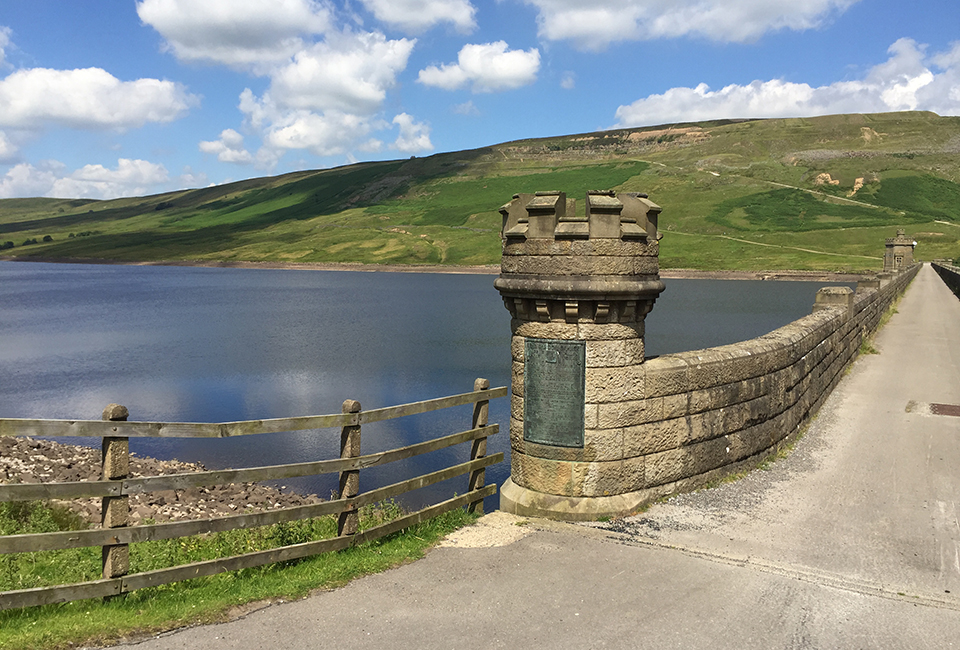We're carrying out essential work that may affect your visit
To keep everyone safe while we're working, we need to close the footpath along the north shore of Scar House reservoir.
Toilets closed
Our ladies' toilets are closed for maintenance.
Discover the natural beauty of Scar House Reservoir
North of Pateley Bridge, deep in the Nidderdale Area of Outstanding Natural Beauty, is Scar House Reservoir sitting below Little Whernside. The natural beauty is paralleled in the masonry which is not only vast at over one million tonnes of stone, but intricately designed. Evidence of the old village, once home to 1250 villagers, can be seen to the left of the road when approaching Scar House.
The surrounding Moorland is being restored by the Yorkshire Peat Partnership, a Yorkshire Water funded project. Peat holds the same amount of emissions as 100 years’ worth of fossil fuels and only grows at 1 mm per year. The moorlands also support a wide range of birds like Curlew, Black Grouse and Hen Harriers, making them a crucial habitat in the UK. For this reason, a lot of the surrounding Moorland is designated as a Site of Special Scientific Interest, meaning they are protected by legislation.
Facilities

Activities
Walks
| Scar House walk | 4 miles | 3 out of 4 |
|
| Scar House & Angram walk | 6 miles | 3 out of 4 |
|
Canoeing
The How Stean Gorge Adventure Club offer Canoeing for all abilities at our Scar House Reservoir.


Visitor information
To keep everyone happy and safe, please:
- follow government guidance
- don’t swim
- take your litter home
- stick to the path
- keep your dog on a lead
- clean up after your dog
- don’t light fires or BBQs.
How to get there
By car
We have a free car park, which is near the end of the reservoir dam and does not have a height barrier. To get here, follow Yorkshire Water’s private tarmac access road, which turns off to the right about 100 metres after Lofthouse village when driving towards Middlesmoor.
To get to Lofthouse Village from Pateley Bridge, follow Low Wath Road for about 7 miles.
From Masham
Follow Fearby Road, which becomes Keld Bank and passes through Healey and Leighton. After Leighton Reservoir, Keld Bank becomes Pott Bank, then Pott Moor High Road, then Trapping Hill before entering Lofthouse Village, about 10 miles from Masham. Take a right at the T-junction, then look out for the Yorkshire Water access road on the right after about 150m.
By public transport
Nidderdale DalesBus 821 runs to Scar House Reservoir Cafe from Keighley, Shipley, Guiseley, Otley and Pateley Bridge on summer sundays and bank holidays.
Frequently asked questions
Can you swim in Scar House Reservoir?
No, you can't swim in Scar House. Reservoirs are really dangerous places and have lots of dangers hidden under the surface. We don't allow anyone to swim in our reservoirs, even if you’re a great swimmer!
Why can’t you swim in Scar House Reservoir?
Scar House Reservoir has lots of hidden dangers. The water is very cold (even in summer) and cold water shock can kill. Scar House Reservoir supplies water to be treated, so there's machinery and strong currents under the water. There may also be blue-green algae, which causes rashes and severe illnesses.
Can dogs swim in Scar House Reservoir?
No, it’s not safe for dogs to swim in Scar House Reservoir and they shouldn’t drink the water. Blue-green algae can form on the surface, which is poisonous and can kill them. There’s also dangerous machinery and strong currents under the water.
Is wild swimming allowed in Scar House Reservoir?
No, Scar House Reservoir is dangerous. Reservoirs aren't the same as natural lakes, they’re man-made and have large machinery that’s working 24/7 just below the surface. They’re also very cold, have strong currents and might have blue-green algae which causes rashes and severe illness.

